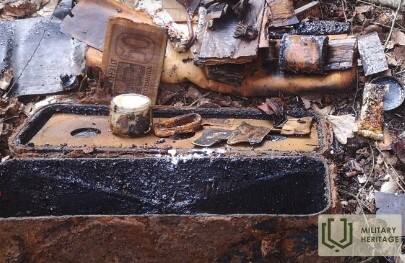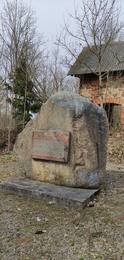Legionieriaus Andrejaus Apsīčio palikimas Remtės girioje
Kuržemės miškuose kartkartėmis aptinkama Antrojo pasaulinio karo įrodymų, nes karo relikvijų ir istorinių senienų entuziastai labai dažnai lankosi Kuržemės miškuose ir laukuose su metalo detektoriais. 2021 metų pradžioje Salduso savivaldybės Remtės pusėje miške užkastoje šaudmenų dėžėje buvo rasti įvairūs dokumentai, patvirtinantys priklausymą Latvijos legiono 19-ajai divizijai, taip pat kareivio asmeniniai daiktai. Jie žemėje pragulėjo 76 metus.
2021 metų pradžioje Saldaus savivaldybės Remtės rajono miške užkastame šaudmenų dėžėje buvo rasti įvairūs dokumentai, įrodantys priklausymą 19-ajai Latvijos legiono divizijai, taip pat kareivio Andrejaus Apsītio asmeniniai daiktai. Jie žemėje pragulėjo 76 metus.
Labiausiai tikėtina, kad dėžė buvo užkasta Remtės miške 1945 m. gegužės pradžioje. Tuo metu šioje pusėje vyko paskutiniai Kuržemės mūšiai ir ten buvo įsikūręs ir 19-osios Latvijos legiono divizijos štabas. Kartu su dokumentais dėžėje buvo ir daug asmeninių daiktų, kurie taip pat apibūdina patį asmenį, pavyzdžiui, pirmajame dienoraščio puslapyje parašytas Aleksandro Čako eilėraštis „Langas verkia rūke“, taip pat buvo įdėti pinigai – ir reichsmarkės, ir červonecai, fotojuostos, uniformų lopai, siuvimo reikmenys.
Šovinių dėžėje taip pat buvo higienos reikmenys – dantų šepetėlis ir buteliukas dantų pastos, kuri buvo išlaikiusi kvapą.
Dėžutėje rasta biografija rodo, kad ji priklausė Andrejui Apsītiui. Jo tėvas Hermanis Apsītis buvo Latvijos teisingumo ministras nuo 1934 iki 1940 m., patyrė represijas ir buvo nužudytas 1942 m. Tuo tarpu apie sūnų Andrejų šiuo metu informacijos yra mažai.
„Žinoma, kad jis gyveno iki 1996 m. ir mirė Rygoje, tačiau šį likusį laikotarpį nuo karo pabaigos iki mirties dienos dar reikėtų ištirti. Būtų puiku, jei pavyktų rasti ir jo giminaičius“, – pripažįsta istorikas Jānis Tomaševskis.
Taip pat lieka atviras klausimas, kodėl pats Andrejus Apsītis dar neaptiko šios užkastos šovinių dėžės.
CŽV medžiaga rodo, kad agentas „Tilbury“ yra buvęs Latvijos legiono karininkas Andrejus Apsītis (1919–1996), kuris po Antrojo pasaulinio karo taip pat buvo Valstybės saugumo komiteto (KGB) agentas, pravarde „Cīrulis“. Kitaip tariant, Apsītis buvo dvigubas agentas, kurio vaidmuo CŽV ir KGB šnipinėjimo žaidime vis dar neaiškus.
https://www.lsm.lv/raksts/zinas/latvija/kurzemes-mezos-atrod-2-pasaules-kara-laika-liecibas.a400911/
https://www.delfi.lv/news/national/politics/noslepumainais-beglis-baltijas-jura-kurzeme-atrastas-kastes-ipasnieks-izradas-dubultagents-tilbury.d?id=53147779
Susijusi laiko juosta
Susijusios temos
Susijusios vietos
Paminklas 8-ajam Raudonosios armijos Estijos šaulių korpusui
Paminklas 8-ojo Raudonosios armijos Estijos šaulių korpuso kariams yra Kaulači pusės dvaro ūkinio namo griuvėsiuose, apie 100 metrų į pietvakarius nuo kelio.
1945 m. kovo 17 d. prasidėjo paskutinis Raudonosios armijos puolimas Kurše. 8-ojo Estijos šaulių korpuso 7-osios Estijos šaulių divizijos užduotis buvo pasiekti Rygos–Liepojos geležinkelio liniją į vakarus nuo Blidenės stoties ir užtikrinti 3-iojo gvardijos mechanizuotojo korpuso ataką Gaikų kryptimi. Kovo 17 d. vakare 354-asis šaulių pulkas pasiekė geležinkelį į pietus nuo Kaulačų pusdvaro per mišką ir tęsė atakas šiaurės vakarų kryptimi, pasiekdamas Pikulių namus. Kaulačų pusdvaryje ir toliau į šiaurės rytus buvo vokiečių Burg-Stellung pozicijos, kurias gynė atskiri 329-osios pėstininkų divizijos daliniai. Visą kovo 18 d. dieną 354-ojo šaulių pulko atakos tęsėsi nesėkmingai.
Kovo 18 d. vakare 354-ąjį šaulių pulką pakeitė 27-asis šaulių pulkas. Puolimui taip pat turėjo būti panaudotas 3-iojo gvardijos mechanizuotojo korpuso 7-osios mechanizuotosios brigados, 1-ojo motorizuotojo bataliono, priešakinis dalinys su viena tankų kuopa. Iki kovo 19 d. vakaro sutelkto puolimo metu sovietai užėmė Kaulačio pusdvarį, užimdami dalį vokiečių pastatytos gynybinės linijos dominuojančioje aukštumoje.
Iki 1945 m. kovo pabaigos 8-ojo Estijos šaulių korpuso ir 3-iojo mechanizuotojo korpuso atakos Vikstraujtės ir Remtės kryptimis tęsėsi, tačiau nesėkmingos.
Kovų metu Kaulačių pusrūmyje buvo įsikūrusios įvairios būstinės, o 1975 m. gegužės mėn. šioje vietoje buvo atidengtas atminimo akmuo.
Remtės dvaro rūmai ir parkas
Remtės dvaro pilis (vok. Remten) – dvaras, esantis Remtėje. Remtės dvaro pastatai ir parkas yra nacionaliniai paminklai. Dvare įsikūrusi Remtės pradinė mokykla. Remtės dvaro rūmai buvo pastatyti 1800 m. Berlyno klasicizmo stiliumi tuometiniam dvaro savininkui grafui Karlui Medemui.
Antrojo pasaulinio karo pabaigoje Remtės dvare ir jo apylinkėse buvo dislokuota Vokietijos armijos grupės Latvijos legiono 19-oji divizija.








